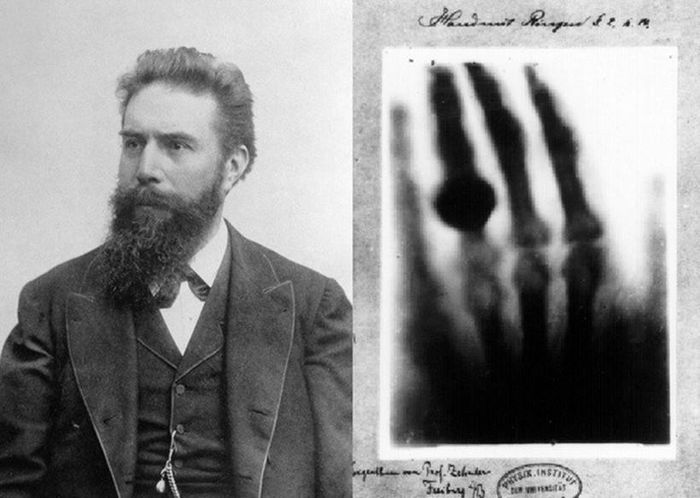Who discovered X-rays?

Wilhelm Conrad Röntgen (1845 – 1923) and mankind's first X-ray photograph.
Wilhelm Conrad Röntgen was the first person to be awarded the Nobel Prize in Physics 'in recognition of his extraordinary contribution to the discovery of the remarkable rays that were later named after him'. This important discovery was the wavelength range of radiation commonly known as X-rays or Röntgen rays.
Road to the Nobel Prize
Röntgen was the son of a German cloth merchant. He was born in 1845 in the Kingdom of Prussia and grew up in the Netherlands. At age 20, he was expelled from the Utrecht Technical School for drawing a caricature of a teacher, although he considered himself unjust. Unable to attend university in the Netherlands due to this disciplinary case, he registered for the Federal Polytechnic Institute in Switzerland and studied mechanical engineering.
After earning his doctorate at the University of Zurich, Röntgen moved to France to work as a lecturer at the University of Strasbourg. After that, he continued to teach at several German universities and lived here.
In 1895, during his research, Röntgen discovered a new type of radiant energy that passed through solid objects and created mysterious light. Later that year, he wrote a scientific paper and used the letter X to represent this wavelength. It is similar to X in mathematical equations to represent an unknown variable.
Soon after the article came out, he created an X-ray image of his wife's hand. This is considered the first X-ray image used to image human bones. This new discovery caused a stir in the scientific world and more than a thousand articles were written about it in 1896.
Also in 1896, Alfred Nobel passed away, leaving his fortune to those who have best served humanity in the fields of Physics, Chemistry, Medicine, Literature and Peace. Röntgen was awarded the first Nobel Prize in Physics in 1901 for his discovery of X-rays.
Röntgen was married and lived with Anna Bertha Ludwig for 47 years, until her death in 1919 at the age of 80. Before that, in 1866, they met in Zürich at Anna's father's cafe Zum Grünen Glas and remained together. On July 7, 1872, they got married in Apeldoorn (Netherlands). This delay was due to Röntgen's father not accepting the age difference between the two (she was 6 years older than him), as well as Anna's humble background.
The two lived together without children. In 1887, they adopted Josephine Bertha Ludwig, then 6 years old, the daughter of Anna's only brother. Röntgen died on February 10, 1923, in Munich (Germany) from colorectal cancer, leaving behind a will requesting the destruction of all his personal and scientific correspondence.
Benefits and dangers of X-rays
Marble bust of Röntgen at the Deutsches Museum in Munich, Germany.
Within a month of Röntgen's discovery being announced, dozens of scientists across Europe and North America attempted to reproduce his results.
Alan Archibald Campbell-Swinton, an electrical engineer in Scotland, was the first person after Röntgen to create images from X-rays. English physician John Hall-Edwards was the first to use X-rays for medical purposes .
He took an X-ray of the hand of a man pricked by a needle in January 1896 and used this image for surgery. In addition, he was also the first person to image the human spine with X-rays.
In the early years, this achievement brought widespread excitement and the public was unaware of the potential dangers of X-rays. Until the Georgian scientist Ivan Romanovich Tarkhanov announced that they had harmful effects. When he acted dangerously on the creatures he experimented with, such as frogs and insects, people began to be startled.
In 1896, Thomas Edison invented the Vitascope, a device that allowed people to view X-rays in real time. But he abandoned this research when his collaborator Clarence Dally developed malignant tumors in his hands, after extensive X-ray imaging.
Around the time of the first recorded death caused by X-rays, physicist Mihajlo Pupin developed a new technology that reduced the exposure time of each image from an hour to a few minutes. However, many scientists have recorded other worrying consequences such as burns and hair loss, cancer, and even infertility, related to X-rays.
Scientist Elizabeth Fleischman worked extensively with X-rays and eventually realized that the damage she was experiencing, such as the burns on her hands, were caused by radiation. She advocates the use of protective shields made of glass and metal. However, the cancer penetrated Fleischman's arms and lungs and she died in 1905 at just 38 years old.
Although not a rich man, Röntgen donated the entire 50,000 krona Nobel Prize amount to the University of Würzburg, where he received an honorary Doctor of Medicine degree, for research. Röntgen never patented X-rays or any of his other discoveries, because he believed that scientific achievements should be open to everyone.
According to Historydefined
You should read it
- The beautiful short hairstyles and the most beloved sisters are today
- Offline still uses Gmail
- Microsoft uploaded the video 'complaining' Siri
- How to use 'Hey Siri' on an old Mac
- How to start and stop services in MS SQL Server
- How to set alarm and timer in Windows 10
- What is Fomo? Psychological syndrome does not belong to anyone
- Please download Sundered: Eldritch Edition, the super cool boss battle game is free
May be interested
- Selecting the right time, rays easily cut giant spider meat
 giant spider crab, also known as japanese spider crab, is the species with the largest foot length among crustaceans, the length from these to more and more of them can be up to 3.7m, double height of an adult.
giant spider crab, also known as japanese spider crab, is the species with the largest foot length among crustaceans, the length from these to more and more of them can be up to 3.7m, double height of an adult. - UVLens application - protects you from harmful UV rays
 if you are concerned about time and how to protect yourself from uv rays in the summer, you can use the free uvlens app for both android and iphone.
if you are concerned about time and how to protect yourself from uv rays in the summer, you can use the free uvlens app for both android and iphone. - Seafaring need to prepare? Pocket checklist of 17 essentials when traveling this summer
 if you do not know what to prepare for the beach, we have a list of suggestions for you right here.
if you do not know what to prepare for the beach, we have a list of suggestions for you right here. - Chameleon fluorescence under ultraviolet light
 chameleon is famous for its ability to constantly change colors and weather. but under ultraviolet light, many species of chameleon are capable of emitting fluorescent light.
chameleon is famous for its ability to constantly change colors and weather. but under ultraviolet light, many species of chameleon are capable of emitting fluorescent light. - The streams of plasma sprayed from black holes can kill anything
 the plasma flow from the black hole produces a large amount of radiation, especially high-energy x-rays and gamma rays, which can destroy anything on their path.
the plasma flow from the black hole produces a large amount of radiation, especially high-energy x-rays and gamma rays, which can destroy anything on their path. - Detect 'exclusive' applications that look through clothes
 symantec's security response department recently discovered a malicious application called android.uracto, to trick people into being able to see through clothing.
symantec's security response department recently discovered a malicious application called android.uracto, to trick people into being able to see through clothing. - Xiaomi released a sterilizer, which can kill the nCoV virus
 xiaoda disinfection lamp with the mechanism of operation is to use ultraviolet rays and dual ozone system to disperse ozone to kill ncov virus in the air.
xiaoda disinfection lamp with the mechanism of operation is to use ultraviolet rays and dual ozone system to disperse ozone to kill ncov virus in the air. - Discovering a 50 km long underground cave, 100 meters wide in the Moon may be a haven for people in the future
 scientists have discovered an underground cave stretching 50 km and 100 meters wide on the moon. this may be the right place for us to build a space base for missions to explore the moon and protect astronauts from radiation and cosmic rays on the surface in the future.
scientists have discovered an underground cave stretching 50 km and 100 meters wide on the moon. this may be the right place for us to build a space base for missions to explore the moon and protect astronauts from radiation and cosmic rays on the surface in the future. - Mycenean-era tombs with dozens of evidence were discovered in Salamina
 a mycenean tomb with ancient goods dating back to the 12-13th century bc was discovered in the center of the main town on salamina island, greece, discovered by chance in a home-link construction project. stay with central sewage network.
a mycenean tomb with ancient goods dating back to the 12-13th century bc was discovered in the center of the main town on salamina island, greece, discovered by chance in a home-link construction project. stay with central sewage network. - Two new species of parasitic plants discovered in Okinawa
 two new species of parasitic plants have just been discovered on okinawa island, japan, discovered and established directly by professor suetsugu kenji (kobe university school of engineering science), receiving the attention of many people.
two new species of parasitic plants have just been discovered on okinawa island, japan, discovered and established directly by professor suetsugu kenji (kobe university school of engineering science), receiving the attention of many people.










 The world's largest gold vault, no bomb can destroy it
The world's largest gold vault, no bomb can destroy it The world's largest fusion reactor, as tall as 6 buildings in Japan
The world's largest fusion reactor, as tall as 6 buildings in Japan Why did the Soviets never set foot on the Moon?
Why did the Soviets never set foot on the Moon? The most exotic waterfalls in the world
The most exotic waterfalls in the world Decipher the miracle on the Hudson River 11 years ago
Decipher the miracle on the Hudson River 11 years ago Learn the 4 most expensive fabrics in the world
Learn the 4 most expensive fabrics in the world